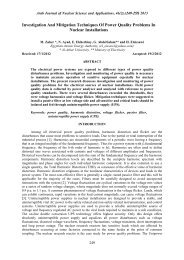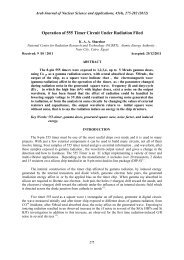Download - Arab Journal of Nuclear Sciences and Applications
Download - Arab Journal of Nuclear Sciences and Applications
Download - Arab Journal of Nuclear Sciences and Applications
You also want an ePaper? Increase the reach of your titles
YUMPU automatically turns print PDFs into web optimized ePapers that Google loves.
<strong>Arab</strong> <strong>Journal</strong> <strong>of</strong> <strong>Nuclear</strong> Science <strong>and</strong> <strong>Applications</strong>, 46(2), (107-114) 2013<br />
In many industrial applications, the mechanical properties <strong>of</strong> Al–Mg alloys are required to be<br />
further improved. One <strong>of</strong> the methods used to improve the mechanical properties <strong>of</strong> Al–Mg alloys is<br />
exposuring the alloy to radiation. The primary cause <strong>of</strong> radiation damage in metals is the displacement<br />
<strong>of</strong> atoms <strong>and</strong> electrons (13) . The radiation damage is actually composed <strong>of</strong> several distinct processes (14) .<br />
These processes <strong>and</strong> their order <strong>of</strong> occurrence are as follows:<br />
1. The interaction <strong>of</strong> an energetic incident particle with the lattice atom.<br />
2. The transfer <strong>of</strong> kinetic energy to the lattice atom giving birth to a primary knock-on atom (PKA).<br />
3. The displacement <strong>of</strong> the atom from its lattice site.<br />
4. The passage <strong>of</strong> the displaced atom through the lattice <strong>and</strong> the accompanying creation <strong>of</strong> additional<br />
knock-on atoms.<br />
5. The production <strong>of</strong> a displacement cascade (collection <strong>of</strong> point defects created by the PKA).<br />
The radiation damage is concluded when the PKA comes to rest in the lattice as an interstitial.<br />
The result <strong>of</strong> a radiation damage event is the creation <strong>of</strong> a collection <strong>of</strong> point defects (vacancies <strong>and</strong><br />
interstitials) <strong>and</strong> clusters <strong>of</strong> these defects in the crystal lattice. Several investigations were carried out<br />
to interpret the effect <strong>of</strong> γ-irradiation on the mechanical <strong>and</strong> electrical properties <strong>of</strong> metals <strong>and</strong> alloys<br />
(15-17) . The results mostly showed that γ-irradiation effect causes increase <strong>of</strong> the strengthening<br />
parameters <strong>and</strong> electrical resistivity <strong>of</strong> the irradiated materials. This was attributed to the irradiationinduced<br />
point defects created in the irradiated materials.<br />
One <strong>of</strong> the most essential phenomena in deformed irradiated metals or alloys is the workhardening.<br />
The effect <strong>of</strong> deformation temperature on the work-hardening characteristics <strong>of</strong> the<br />
irradiated Al based alloys was found to return backs the initial values <strong>of</strong> the strengthening parameters<br />
(15) . This was attributed to the annihilation <strong>of</strong> the irradiated defects at their sinks at temperatures where<br />
the defects become appreciably mobile (18) .<br />
The present work is devoted to get an insight <strong>and</strong> provide some additional information about the<br />
effect <strong>of</strong> γ-irradiation <strong>and</strong> the reverse effect <strong>of</strong> the deformation temperature on the work-hardening<br />
parameters <strong>of</strong> Al-5356 alloy.<br />
(i) Sample Preparation<br />
EXPERIMENTAL PROCEDURES<br />
This study has been carried out on commercial Al-5356 alloy supplied from Alumisr factory-<br />
Helwan-Cairo-Egypt in the form <strong>of</strong> rod <strong>of</strong> 3mm in diameter. The chemical compositions <strong>of</strong> the alloy<br />
under investigation are given in Table (1). The rods were cold drawn in steps into wires 0.6 mm in<br />
diameter for stress-strain measurements. A part <strong>of</strong> the alloy was rolled into sheet <strong>of</strong> 0.3mm in<br />
thickness <strong>and</strong> 5mm width for microstructure investigation.<br />
Table (1): The chemical compositions <strong>of</strong> the Al-5356 solder alloy<br />
Al Mg Fe Cu Si Mn Cr Zn Ti Be<br />
93.5-94.5 4.5-5.5 0.4 0.1 0.25 0.05-0.2 0.05-0.2 0.1 0.06-0.2 0.0008<br />
(ii) Heat Treatment <strong>and</strong> Irradiation Techniques<br />
Samples in the form <strong>of</strong> sheet (5 x 5 x 0.3 mm) <strong>and</strong> wires (50 mm in length) were annealed for<br />
5h at 773K in the solid solution region using a thermo regulated furnace. The temperature inside the<br />
701












